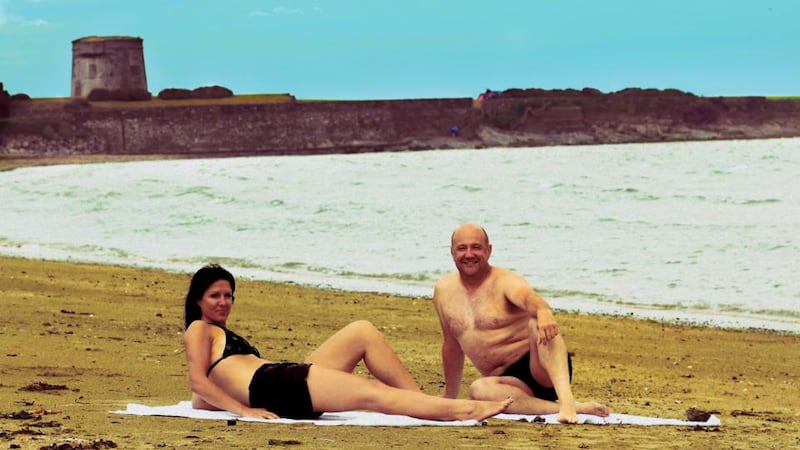I don’t know why it is so amusing to see a tanned, handsome man in sunglasses lounging on a beach holding a rather large camera in a strategic position, but it is. Everyone I show the John Hinde postcard to has a similar reaction. The couple at the forefront of the image look so glamorous and somehow so unlikely as candidates on an Irish beach in the late 1960s, when this image was probably taken.
Red Island was the name of the seaside holiday accommodation in the background of the postcard. It opened in 1947 and could host 500 people. It was owned and run by Eamonn Quinn, Feargal Quinn’s father. He apparently loathed people referring to Red Island as “a holiday camp”, preferring “holiday hotel”, although it seems he lost that battle.
Skerries resident Tony Keeling, who is showing me around, takes me through each of the buildings in the image. The blocky shape under the Martello tower was a place for changing. Its flat concrete roof was the most sought-after sunbathing spot in Skerries, nicknamed “the ovens” because of its reputation as a sun-trap. To the right was a building that held pool tables and a rollerskating rink.


Next was the stables. One of Keeling’s jobs was to look after the horses. Behind the stables were mini-golf and tennis courts. “There were beautiful gardens, with professional gardeners,” he says. More than 100 people worked on site during peak season.
The big glass-fronted building with the curved roof served as both a dining room and a ballroom. You ate what was put in front of you: chips, sausages, eggs, bacon. “There wasn’t a menu and there was no choice. It was a bit like the army,” says Keeling. In the evening, the room was revamped into a ballroom. Entertainers included regulars Maureen Potter and Hal Roche, and a ventriloquist.
Keeling played in a four-piece band, The Rings Skiffle Group, in the long veranda and lounge area next to the ballroom. He was only 11 during his first season. One band member played a stringed tea chest. “The audience wasn’t very sophisticated,” he says, laughing.
The four of them were paid five shillings a session between them. “I used to do Elvis quite well. He was only new on the scene at the time. We’d do Lonnie Donegan, Little Richard, Ricky Nelson.”
Bands that played the ballroom included Thin Lizzy and Horslips. "The word has always been that Bono played his first gig here, at Red Island, supporting Horslips," Keeling says. (Answer on a postcard to me here at The Irish Times, please, Bono.)
North of England
According to Keeling, most of the visitors came from the north of England by boat. New groups arrived each Saturday. On the extreme right of the postcard was the accommodation.
The Martello tower at the edge of the postcard, now boarded up, was used as extra staff accommodation in the summers. Brendan Grimes was one of the people who stayed there over a few summers. He now lives in Skerries. He worked with the in-house photographer, Barry Mason, processing film.
“I can’t even remember if there were lavatories in it,” he says. “There were about five of us in a round circular room.”
He recalls being paid £6 a week. Very few people had cameras then (one exception being our friend on the beach). “We’d take pictures of them during the day, or when they went off on tours, and the pictures would be pinned up on big boards outside the dining room each evening, with a number, and if you liked it, you bought it.”
The last day of the Red Island holidays was always a Friday; the changeovers were on a Saturday. Tony Keeling recalls a bizarre ritual that routinely took place on Friday evening: “People marched out in conga style and they stood at the bottom of the Martello tower.”
All I can do is laugh when Keeling tells me of the quaint bit of theatre that was considered entertainment for the departing Red Islanders.
“A Mother Machree type woman – you know, an ancient Irish woman with mystery attached to her – would appear on the roof of the Martello tower. She’d make ghostly kinds of sounds. Sometimes she’d have a broomstick and wave it at them. Except it wasn’t a lady at all – it was a man dressed up, usually Terry Toland or Bob the photographer.”
The Red Island complex was demolished in the 1970s and the land bought by the local council. A prime site on the sea, it happily escaped proposed development as an apartment complex. Keeling says that a local man told him that before Red Island was ever built, there were hayfields on the site, which starlings used to visit.
After the complex was built, the birds vanished. When it was demolished, so the story goes, they returned.
Nothing remains of the Red Island complex now, except the memories. It is now a beautiful amenity for the people of Skerries, with swimming places and a park, fronting the lovely, wide sandy beach. That's the beach on which spirited local volunteers Paul Lambkin and Kasia Brandys posed, to reconstruct the postcard image.
The sky was not blue that day, although you might be fooled into thinking it was, thanks to the John Hinde-style colour processing applied to the photograph.








